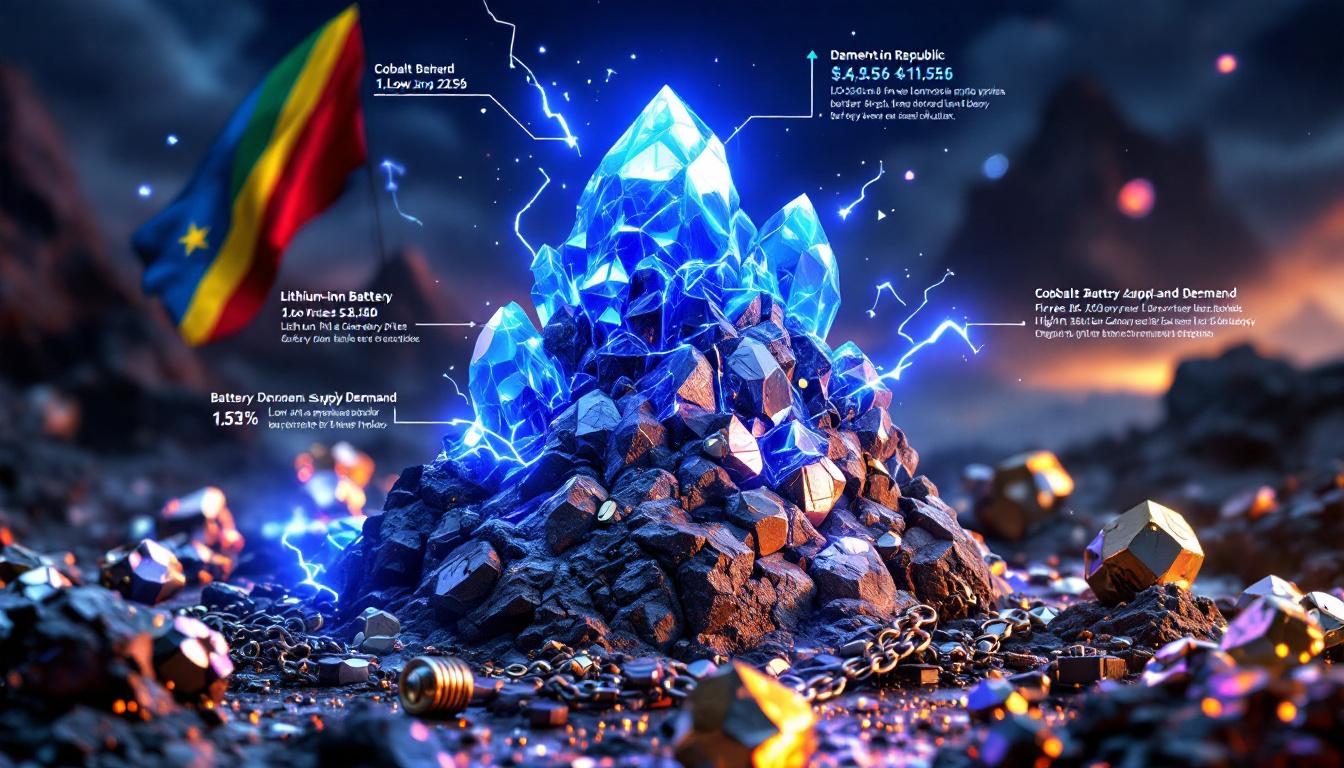Why Has Nornickel Revised Its 2025 Nickel Surplus Forecast?
The global nickel market is experiencing significant adjustments as major producer Nornickel has recently revised its surplus projections for 2025, reducing its forecast from 150,000 tons to 120,000 tons. This 30,000-ton reduction represents a substantial shift in market expectations and suggests improving fundamentals in what has been a challenging market environment.
Despite volatility in other metal markets, nickel prices have demonstrated remarkable stability throughout 2025, consistently trading within the $15,000-$16,000 per ton range. This price stability stands in stark contrast to the more erratic movements seen in related metals, particularly platinum, which recently reached 11-year highs.
Current Nickel Market Overview
"Despite the continued increase in nickel production in China and Indonesia, we are observing steady demand for nickel in China," stated Nornickel in its latest market review. This resilient Chinese consumption has been a key factor supporting prices and prompting the revised surplus projection.
The reduced surplus forecast comes alongside Nornickel's projection of a 130,000-ton surplus for 2026, indicating the company anticipates continued but manageable oversupply conditions in the medium term. This outlook has significant implications for producers, consumers, and investors throughout the nickel value chain.
| Metric | Previous Forecast | Updated Forecast | Change |
|---|---|---|---|
| 2025 Nickel Surplus | 150,000 tons | 120,000 tons | -30,000 tons |
| 2026 Projected Surplus | Not previously reported | 130,000 tons | N/A |
| Palladium Market 2025 | Not specified | Balanced | No surplus/deficit |
| Palladium Market 2026 | Not specified | Balanced | No surplus/deficit |
| Palladium Demand 2025 | Not specified | 9.1 million ounces | -2% year-over-year |
What Factors Are Driving This Market Adjustment?
Several key factors are influencing Nornickel's revised outlook for the nickel market, with supply-demand dynamics showing more balance than previously anticipated.
Strengthening Chinese Demand
China's appetite for nickel has proven more resilient than many analysts expected, helping to offset the continued production growth from both Chinese and Indonesian operations. This demand strength is particularly notable given concerns about China's broader economic slowdown and challenges in its property sector.
"The improvement in fundamental market indicators and the reduced surplus inspire confidence in the short and medium term for the nickel market," Nornickel noted in its assessment. This resilient demand has been instrumental in absorbing a portion of the additional supply entering the market.
Production Profitability Challenges
Approximately 25% of global nickel producers are currently operating at a loss given prevailing market prices—a statistic that suggests potential supply-side adjustments may be forthcoming. This economic pressure creates a natural mechanism for market rebalancing, as these unprofitable operations face difficult decisions regarding continued production.
"Unprofitable production sites outside Indonesia could close in the near future," Nornickel stated, highlighting the economic reality facing higher-cost producers. Indonesia's lower-cost operations are likely to remain viable even at current price levels, but producers in other regions face more significant challenges.
The potential supply responses could include:
- Closure of high-cost operations outside Indonesia
- Consolidation among smaller producers seeking economies of scale
- Delays or cancellations of planned expansion projects
- Strategic production curtailments at marginal operations
- Inventory management to reduce market oversupply
Indonesian and Chinese Production Growth
The ongoing expansion of nickel production capacity in Indonesia continues to be the primary driver of market surplus. Indonesia's transformation into a nickel processing powerhouse has fundamentally altered global supply dynamics, with the country's lower-cost production putting pressure on competitors worldwide.
However, the rate of new supply entering the market appears to be moderating relative to earlier projections. This slowing expansion pace, combined with steady demand, has contributed to Nornickel's revised surplus forecast. The Indonesian nickel challenges have played a significant role in reshaping market expectations for 2025 and beyond.
How Will This Affect Different Market Participants?
The evolving nickel market dynamics will have varied implications across the value chain, from miners to end-users and investors.
Implications for Nickel Producers
For producers, current market conditions present a bifurcated landscape. Low-cost Indonesian operations maintain comfortable margins even at current price levels, while higher-cost producers face challenging economics that may force difficult decisions.
The 25% of producers operating at a loss must evaluate strategic options including:
- Cost-reduction initiatives to improve competitiveness
- Temporary production curtailments to preserve resource value
- Permanent closure of highest-cost operations
- Seeking consolidation opportunities with stronger operators
- Diversification into value-added products with better margins
For investors in nickel producers, cost position has become the critical metric to evaluate, with low-cost operators offering more resilient investment profiles in the current market environment.
Impact on Battery Supply Chain
For battery manufacturers and electric vehicle (EV) producers, the nickel market's dynamics have significant implications. The stable price environment provides predictability for procurement strategies, while the anticipated surplus suggests supply security is unlikely to be a major concern in the near term.
The battery metals landscape continues to evolve, with nickel playing a crucial role in high-energy density battery chemistries. The battery supply chain benefits from:
- Price stability allowing for more accurate cost forecasting
- Sufficient supply availability for planned production expansion
- Potential for favorable long-term supply agreements
- Opportunity to optimize battery chemistries with price certainty
- Reduced risk premiums in procurement strategies
The consistent price range of $15,000-$16,000 per ton has allowed battery manufacturers to plan production with greater certainty compared to the volatile conditions seen in other battery metals like lithium and cobalt in recent years.
Investment Considerations
For investors monitoring the nickel space, Nornickel's revised projections suggest a potentially more balanced market outlook than previously anticipated. While still projecting surplus conditions, the reduced oversupply forecast indicates less downward pressure on prices than earlier expected.
Key investment opportunities 2025 in the nickel sector include:
- Potential stabilization in pricing around current levels
- Possible upside if high-cost production cuts materialize
- Strategic advantage for low-cost Indonesian operations
- Continued challenges for higher-cost Western producers
- Growing importance of ESG credentials as a differentiator
"The improvement in fundamental indicators inspires confidence despite macroeconomic uncertainty," Nornickel noted, suggesting that despite surplus conditions, there are reasons for cautious optimism about market stability.
What's Happening in Related Metals Markets?
Understanding nickel's outlook requires contextualizing it within the broader metals complex, particularly the platinum group metals (PGMs) that Nornickel also produces.
Palladium Market Dynamics
While nickel faces a surplus situation, the palladium market presents a more balanced picture. Nornickel, as the world's largest palladium producer, forecasts:
- A balanced market for both 2025 and 2026, without significant surplus or deficit
- Approximately 2% decrease in palladium demand for 2025, with consumption projected at 9.1 million ounces
- Potential production growth in 2026 with Russian Platinum's new Chernogorsk deposit coming online
This balanced outlook for palladium contrasts with nickel's surplus conditions, reflecting the different supply-demand dynamics in each metal's primary end-use markets.
Platinum's Contrasting Bull Market
In stark contrast to nickel's stable price performance, platinum has experienced significant price appreciation in 2025, recently reaching 11-year highs due to supply concerns. This divergence highlights how different fundamentals are driving various metal markets, with supply constraints supporting platinum while nickel navigates surplus conditions.
The platinum market's tightness demonstrates how quickly metal markets can shift from surplus to deficit when supply disruptions occur, providing a potential roadmap for how nickel's market balance could evolve if significant production cuts materialize.
Comparative Metals Market Performance
Nickel's price stability stands out when compared to:
- Platinum's surge to 11-year highs
- Copper's volatility in response to global economic indicators
- Lithium's continued price weakness amid persistent oversupply
- Cobalt's gradual recovery from previous lows
This divergence in performance highlights the importance of understanding the specific supply-demand fundamentals of each metal rather than viewing "battery metals" or "base metals" as homogeneous categories.
What Could Change This Market Outlook?
Several factors could alter Nornickel's revised forecast, introducing both upside and downside risks to the projected surplus.
Geopolitical Risk Factors
Multiple geopolitical considerations could impact the nickel market outlook:
- Implementation of new U.S. trade tariffs affecting metal imports
- Ongoing tensions in the Middle East potentially disrupting supply chains
- Potential sanctions affecting Russian metal exports
- Indonesia's evolving export and processing policies
- China's economic growth trajectory and stimulus measures
The geopolitical mining landscape continues to influence market dynamics, with any significant changes in trade policy or political tensions potentially disrupting established supply chains or altering demand patterns. Under certain scenarios, these factors could shift the market from surplus toward balance or even deficit.
Technology and Demand Shifts
Technological developments represent another source of potential market disruption:
- Evolving battery chemistries in electric vehicles (shifting nickel intensity)
- Advancements in nickel processing technologies altering cost curves
- Shifts in stainless steel manufacturing techniques changing nickel consumption
- Development of enhanced nickel recycling capabilities increasing secondary supply
- Emergence of alternative materials for key applications reducing primary demand
The battery sector remains particularly important to watch, as shifts in cathode chemistry preferences could significantly impact nickel demand projections. A faster-than-expected transition to high-nickel cathodes would support demand, while greater adoption of lithium iron phosphate (LFP) chemistries would reduce nickel intensity.
Production Response Scenarios
The market's evolution will depend significantly on how producers respond to current conditions:
- Acceleration of production cuts at unprofitable operations
- Delay or cancellation of planned expansion projects
- Consolidation through mergers and acquisitions
- Strategic inventory management by major producers
- Investment in cost-reduction technologies
Projects like the Tamarack nickel-copper project represent new supply potential that must be balanced against possible closures of existing operations. The speed and scale of supply-side adjustments will be critical in determining whether the market surplus narrows faster than currently projected or persists longer than anticipated.
How Should Market Participants Interpret These Developments?
Nornickel's revised forecast provides valuable insights for different stakeholders, but requires careful interpretation within the broader market context.
Short-Term Market Indicators to Watch
Key metrics that will signal the market's direction in coming months include:
- LME and SHFE nickel inventory levels and trends
- Chinese stainless steel production rates and inventory positions
- Indonesian nickel pig iron (NPI) and matte production volumes
- Price spreads between Class 1 nickel and lower-grade products
- Producer announcements regarding operation curtailments or closures
These indicators will provide early warning signs of whether the market is moving toward Nornickel's revised forecast or deviating from it.
Medium-Term Strategic Considerations
For longer-term planning, market participants should consider:
- Indonesia's evolving role in global nickel processing
- The pace of electric vehicle adoption and battery chemistry trends
- Potential regulatory changes affecting nickel production or consumption
- Development timelines for major new nickel projects globally
- Progress in recycling technologies and circular economy initiatives
Understanding these structural factors will help stakeholders position for different potential market scenarios beyond the immediate forecast period.
Hedging and Risk Management Strategies
Given the current market outlook, prudent risk management approaches include:
- Producers considering strategic hedging programs to lock in current prices
- Consumers evaluating long-term supply agreements to secure material
- Investors diversifying exposure across different nickel production types
- All participants monitoring key signposts for potential market inflection points
- Maintaining scenario planning for both continued surplus and potential rebalancing
The 25% of producers operating at a loss face particular pressure to implement risk management strategies that provide breathing room for operational adjustments.
FAQ: Key Questions About the Nickel Market Outlook
Why does a 30,000-ton reduction in surplus forecast matter?
The 30,000-ton reduction represents a 20% decrease from the previous surplus projection, which is significant in terms of market psychology and potential price support. While still projecting a surplus, this adjustment suggests less downward pressure on prices than previously anticipated.
In a global nickel market of approximately 3 million tons annually, a 30,000-ton shift in the supply-demand balance can meaningfully impact market sentiment and price formation, particularly if it signals the beginning of a trend rather than a one-time adjustment.
What is causing the nickel market surplus?
The primary driver of the nickel surplus is the rapid expansion of production capacity in Indonesia and China, which has outpaced demand growth. Indonesia's development of nickel processing facilities has been particularly significant in transforming global supply dynamics.
Indonesian production benefits from:
- Lower operating costs compared to many Western operations
- Integrated mine-to-processing facilities reducing logistics costs
- Supportive government policies encouraging downstream processing
- Proximity to Chinese markets and technology partnerships
- Abundant high-grade laterite resources
This structural shift in global production has created persistent oversupply despite steady demand growth.
Why has Nornickel reduced its surplus forecast?
Nornickel has lowered its surplus projection primarily due to:
- Stronger-than-expected demand in China despite broader economic challenges
- The likelihood that some unprofitable production outside Indonesia may close in response to current price levels
- Slightly slower pace of new supply growth than previously anticipated
As a major producer with global market presence, Nornickel has visibility into both supply and demand dynamics that inform its market assessments.
How might nickel prices respond to these revised projections?
While still projecting a surplus situation, the reduced surplus forecast suggests less downward pressure on prices than previously anticipated. If production cuts materialize from higher-cost producers, this could provide additional price support.
According to Argus Media, the most likely scenario based on current fundamentals is continued price stability within the established $15,000-$16,000 per ton range, with potential for modest upside if supply adjustments accelerate or downside if demand weakens unexpectedly.
What is the relationship between nickel and electric vehicle batteries?
Nickel is a critical component in many electric vehicle battery chemistries, particularly in high-energy density nickel-manganese-cobalt (NMC) and nickel-cobalt-aluminum (NCA) cathodes. Higher nickel content generally enables greater energy density and vehicle range.
Key nickel-battery relationships include:
- NMC 811 batteries contain approximately 80% nickel in the cathode
- A typical EV with high-nickel chemistry may contain 40-80 kg of nickel
- Battery-grade nickel requires additional processing beyond standard Class 1
- Alternative LFP (lithium iron phosphate) batteries use no nickel but offer lower energy density
- Recycling of nickel from batteries is becoming increasingly important for supply
The growth trajectory of EVs and the evolution of battery chemistries remain critical variables for long-term nickel demand forecasts.
How significant is Nornickel in the global nickel market?
Nornickel is one of the world's largest refined nickel producers and a major player in the global market. The company's production and market assessments are closely monitored by industry participants as important indicators of market direction.
As a low-cost producer with significant scale, Nornickel's market outlook carries particular weight, especially regarding Russian production and the interplay between nickel and platinum group metals markets, where the company has substantial presence.
What production sites are most at risk of closure?
While Nornickel didn't identify specific operations, high-cost nickel mines and refineries outside Indonesia are most vulnerable in the current price environment. Operations with the following characteristics face the greatest pressure:
- Higher-cost sulfide operations in Canada, Australia, and Finland
- Aging facilities requiring significant capital investment
- Operations with high energy costs or challenging logistics
- Standalone mines without integrated processing facilities
- Production sites with limited economies of scale
Any closures would likely begin with temporary curtailments before progressing to permanent shutdowns if market conditions don't improve.
What signals would indicate a shift from surplus to balanced market?
Key indicators that would suggest the market is moving toward balance include:
- Declining warehouse inventory levels at LME and SHFE
- Announcement of significant production cuts from major producers
- Widening premiums for physical delivery over exchange prices
- Steepening forward curve from contango toward backwardation
- Accelerating price momentum on relatively modest trading volume
These market signals typically precede fundamental rebalancing and would suggest Nornickel's revised forecast might be trending toward further reductions in projected surplus.
Ready to Spot the Next Major Mineral Discovery?
Discovery Alert's proprietary Discovery IQ model instantly identifies significant ASX mineral discoveries, providing actionable insights and a competitive edge for both short-term traders and long-term investors. Explore how historic discoveries have generated substantial returns by visiting our dedicated discoveries page and begin your 30-day free trial today.




